The Kookaburra is, perhaps, the most iconic of Australia’s many beautiful and fascinating birds. Not only is the Kookaburra, like the emu, a common national symbol for Australia, but this unique and stunning bird is also intimately familiar to audiences around the world. (1)
Although you may have never seen a Kookaburra if you aren’t from Australia or New Guinea, the odds are pretty good that you have listened to the distinctive cackling call of the Kookaburra. The Kookaburra is, in fact, one of the most commonly used stock sound effects in the animal kingdom. From old movies to theme park attractions, the “ooh ooh ah ah ah” call of the Kookaburra has been used to evoke a jungle-like atmosphere, even in settings that are intended to be far from Australia. In fact, the sound of the Kookaburra is often interpreted as the calling or chattering of monkeys. (2)
The Kookaburra is one of Australia’s most beloved symbols. In this article, we’ll look at the myths and stories connected with the Kookaburra as well as some of the most interesting facts and traits connected with this ubiquitous bird.
Kookaburra Symbolism and Meaning
The first and most obvious symbolic connection for the Kookaburra is with Australia itself. People from Australia may hold the Kookaburra especially dear. It is often taken as both a symbol of patriotism, of national community and pride, and as a symbol of the amazing diversity of unique wildlife that call Australia home.
Kookaburras may also represent mistaken identity or Hollywood magic, thanks to their prevalence as a sound effect for films.
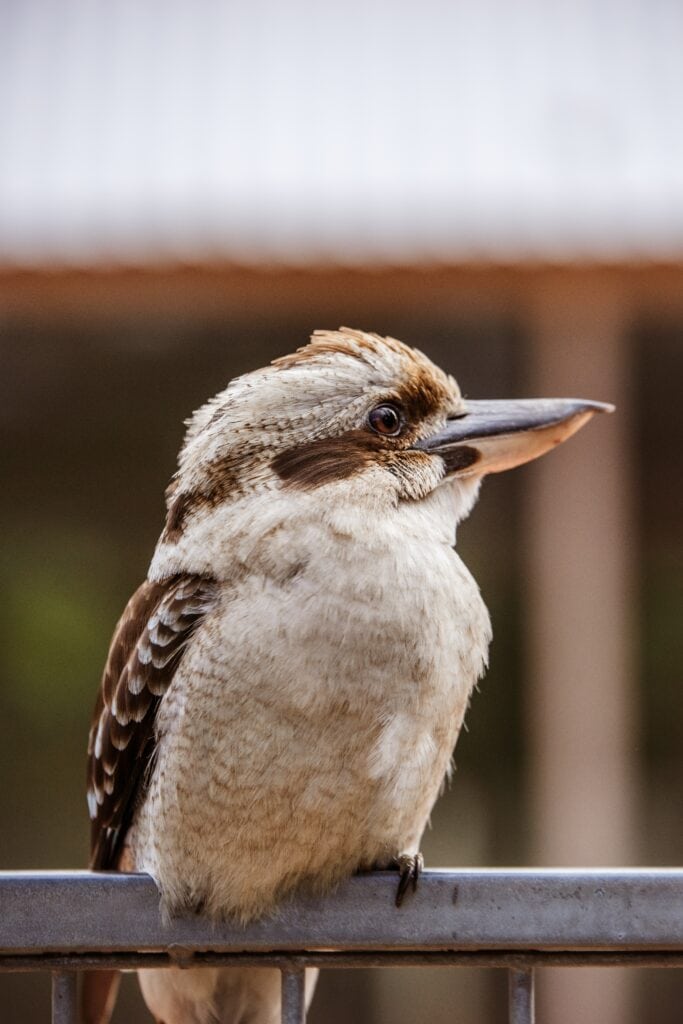
The call of the Kookaburra is one of its most recognizable features. Kookaburra calls are often likened to laughter. In fact, the most common Kookaburra species is called the “Laughing Kookaburra.” For this reason, Kookaburras may be connected with joy, humor, light-heartedness, childishness, innocence, or mischief. (3)
“Kookaburra sits on the old gum tree,
Merry merry king of the bush is he.
Laugh, Kookaburra, laugh, Kookaburra,
Gay your life must be!“— Marion Sinclair’s “Kookaburra Song” (1932) (4)
Traditional myths and superstitions often connect the Kookaburra with good luck or new beginnings. Some superstitions claim that a Kookaburra’s presence signifies an upcoming pregnancy. Other superstitions connect this bird with the coming of rain, or paradoxically, the coming of fair weather. In any case, the Kookaburra can be associated with optimism, a fresh start, or prescience. (5)
Kookaburras might look like they belong to a family unto themselves, but they are actually large members of the kingfisher family. Like other kingfishers, can be connected to patience, serenity, or the idea of “Halcyon Days” of peace and ease. (6)
Kookaburras are remarkably brave around humans. They are commonly found in suburban areas in Australia. In these areas, Kookaburras can be so fearless as to appear docile. Interacting too closely with wild birds is never a good idea, but this courage and relative docility is still noteworthy. Kookaburras are even sometimes kept as exotic pets. Kookaburras may be connected with courage, sociability, intelligence, or domesticity.
While other kingfishers primarily dine on fish, Kookaburras actually primarily dine on insects, reptiles, rodents, and even other birds. They hunt by sitting motionless and swooping onto unsuspecting prey, which they catch and beat to death against their perch. This brutal ambush hunting method associates the Kookaburra with patience, maturity, and efficiency. (7)
Kookaburra Native American Symbolism
Kookaburras are not found in the Americas. Regardless, kingfishers are connected with magic and shamanic abilities in many Native American traditions.
Kookaburra Christianity Symbolism
Christianity did not encounter the Kookaburra until Australia was colonized in the late eighteenth century. The Kookaburra, then, is not a major part of most Christian traditions. There is, however, a Christian myth which accuses the kingfisher, the family to which Kookaburras belong, of letting Noah down during the myth of the flood in the book of Genesis. According to this legend, the kingfisher was released from the ark before the dove, but the bird was overly excited and forgot its duty to return to Noah. (8)
Kookaburra Celtic Symbolism
Kookaburras are not found in the Celtic world, but Celtic mythology generally associates birds with the Otherworld.
Kookaburra in Dreams
Dreaming of a Kookaburra may signal great things on the horizon. Kookaburras are often thought of as symbolizing good luck or new beginnings. Dreaming of a Kookaburra might indicate that one’s luck will soon change for the better.
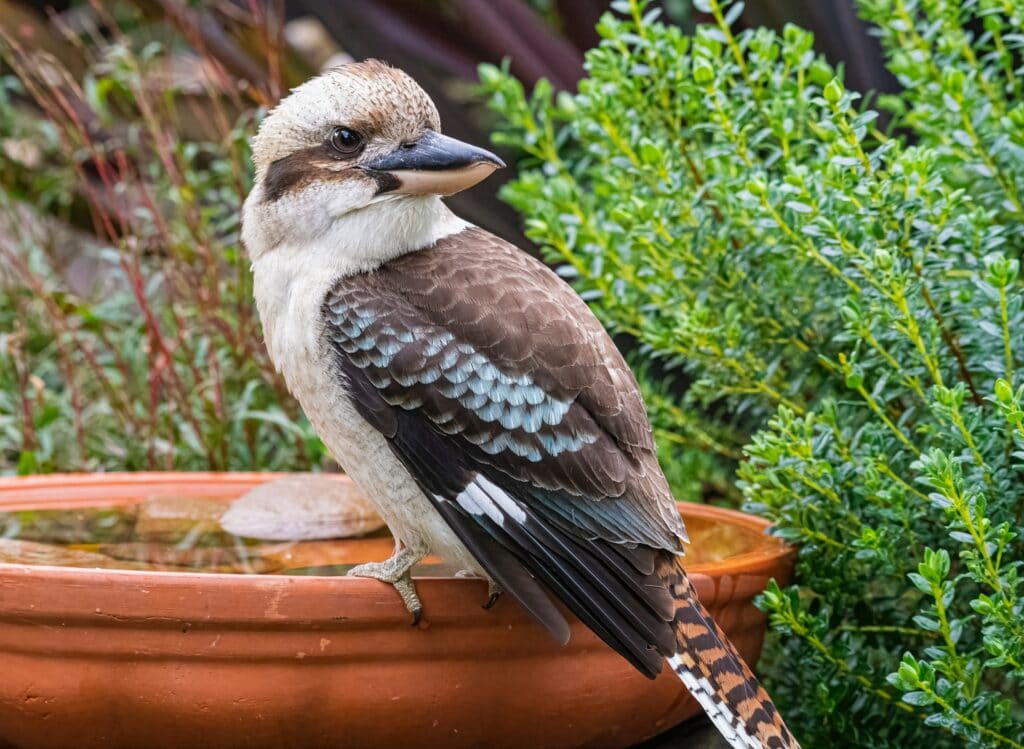
A Kookaburra dream may also be a reminder not to take things too seriously. The Kookaburra might be best-known for its loud and raucous laugh. A Kookaburra dream might signify the need to let loose once in a while. Not only is laughing an important outlet, but the Kookaburra is also loud and proud no matter what. Dreaming of a Kookaburra may symbolize the need to own one’s voice and express oneself without fear or shame. The Kookaburra is a great example of the old adage “dance like nobody is watching.”
Kookaburra Encounters and Omens
Encountering a Kookaburra is sometimes said to indicate that one is pregnant or will soon fall pregnant. People sometimes expand this idea to include the possibility that a friend of family member of the person who encounters the Kookaburra could be the one that falls pregnant. (9)
A Kookaburra encounter may indicate a need for patience. Kookaburras are ambush hunters which sit still for long periods until they spot the appropriate prey. Encountering one might be a reminder not to act out until you are quite certain that the timing is exactly right. A Kookaburra encounter can caution you against being hasty or rash.
Kookaburra in Mythology & Folklore
In this section, we’ll look at several Aboriginal Australian Kookaburra myths as well as one of the most influential kingfisher myths ever.
Aboriginal Mythology:
According to Aboriginal mythology, the world was once a place of darkness. Then, one day, one of the emu’s eggs was cracked in the sky and collided with some firewood, causing it create a big yellow fire which illuminated the whole world. When this occurred, the gods saw that the world was beautiful when it was lit up in this way. They decided to light a fire in the sky every single day. At first, the gods sent the morning star to wake the people in the morning so that they could enjoy the light of the fire. The people were sleeping, though, and could not see the fire. Then, the gods heard the joyous laugh of the Kookaburra. So, they gave the Kookaburra a job. Each morning, the Kookaburra would sing to awaken the world so that all could enjoy the light of the gods’ enormous fire in the sky. For that reason, the Kookaburra is considered a herald of the morning sun. (10)
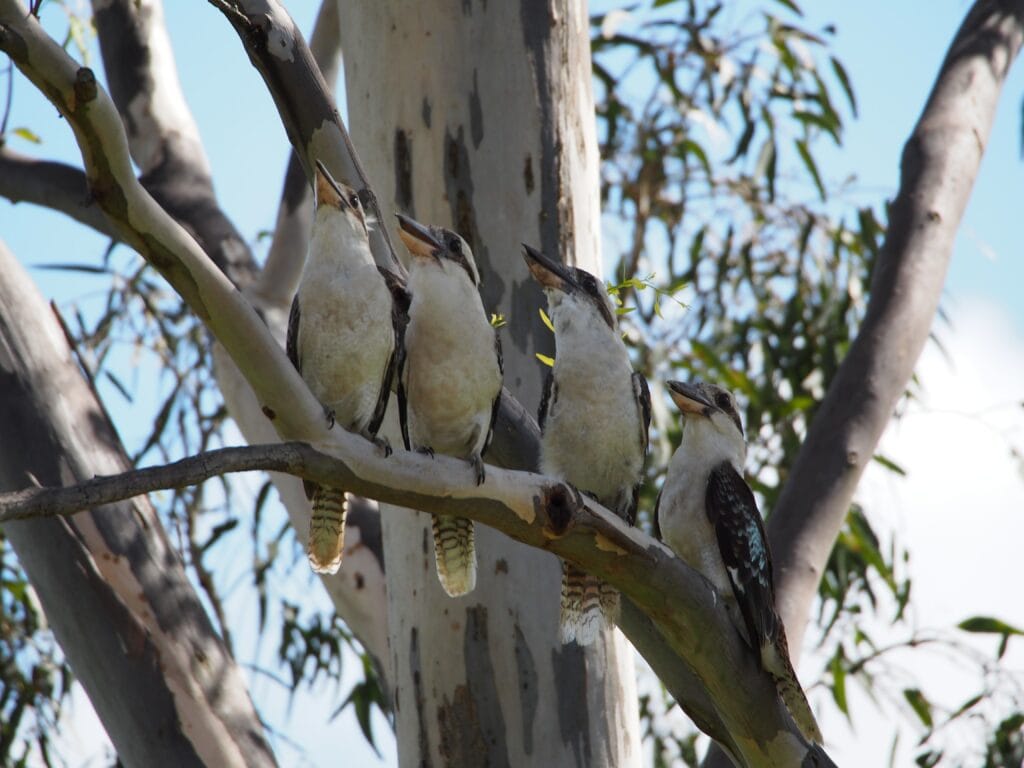
Because of this myth, the Kookaburra commands respect within Aboriginal traditions. It is said that to laugh back at the Kookaburra, or to harass or insult this bird, might bring misfortune. One legend even states that a child who mocks the Kookaburra will grow crooked teeth as punishment. (11)
According to another Aboriginal legend, the lyre-bird once stumped the kingdom of the birds by flawlessly imitating each birds’ song. One by one, the birds sang and the lyre-bird declared its superiority as a singer by successfully copying their songs. Then, the clever Kookaburra challenged the lyre-bird, but instead of singing beautifully, he cackled the most outrageous and ridiculous laugh that he could muster. When the lyre-bird copied it, the sound was so funny to the Kookaburra, who was very proud of his trick, that he kept laughing and laughing and to this day he laughs when he remembers the elegant lyre-bird cackling so madly. (12)
Greek Mythology:
The myth of Alcyone and Ceyx is one of the most famous bird myths in all of mythology. According to this story, Alcyone, who was the daughter of the god of the wind, deeply loved Ceyx, who was the son of the morning star. Ceyx and Alcyone’s love was deep and beautiful and even drew the attention of the gods who enjoyed watching the pair. One day, not knowing that the gods watched them, Alcyone and Ceyx compared their love to that of Hera and Zeus. For their insolence, the gods laid a curse upon them which prophesied that Ceyx would die at sea. Despite begging her lover not to sail, Ceyx ignored the prophecy and died at sea shortly after. When Alcyone begged the gods to return him to her, they allowed Ceyx’s body to wash ashore. Anguished, Alcyone threw herself into the sea. The gods were filled with remorse and decided to reunite the two by transforming Alcyone and Ceyx into kingfishers. The name “Alcyone” means “kingfisher” in Greek. seabird. To continue to punish the pair, Zeus insisted that Alcyone must only build her nest at sea, and only in the depths of winter. Alcyone and Ceyx tried, but the sea was too rough and they kept losing their eggs. The gods pitied the pair once again. Unwilling to revoke his punishment, Zeus instead decided to create ten days of perfect weather and a calm still ocean each year. These days became known as the “Halcyon Days” and were the only periods during which Alcyone and Ceyx could safely build their nest. To this day, periods of idyllic calm, warmth, or tranquility are known as “Halcyon Days.” (13)
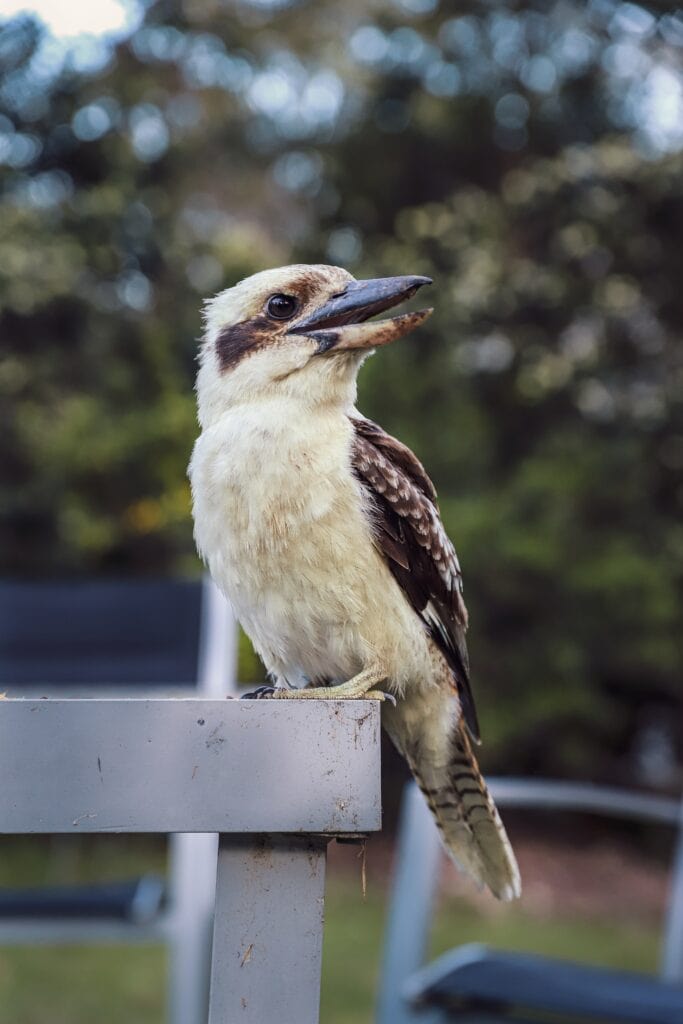
Not only are Kookaburras kingfishers, but the Kookaburra genus is called Dacelo. The name “Dacelo” is an anagram of “Alcedo” which is the Latin word for “Alcyon” or kingfisher.
Kookaburra Spirit Animal
If your spirit animal is the Kookaburra then you likely have a sociable nature and a good sense of humor. People with the Kookaburra as their spirit animal are young at heart, have a propensity for mischief, and do not take themselves too seriously. The Kookaburra spirit animal is fun-loving and playful. Despite these childlike traits, the Kookaburra spirit animal can be shockingly mature and wise in the right contexts. People with the Kookaburra as their spirit animal know that certain situations call for patience and maturity and they are able to call upon these traits when necessary.
Kookaburra Totem Animal
The Kookaburra totem animal is associated with optimism and motivation. The Kookaburra totem never loses its will to go on because it never loses its sense of positivity. The Kookaburra totem understands innately that the sun will rise anew tomorrow and bring about fresh opportunities. As such, the Kookaburra does not dwell upon misfortunes or mistakes. Instead, the Kookaburra totem looks towards the future with hope and embraces change with a sense of joy and gratitude.
Kookaburra Power Animal
The Kookaburra power animal is connected with one’s sense of self. It takes immense confidence to be able to laugh at oneself sincerely. The Kookaburra power animal grants one the perspective to truly know and understand one’s worth. This ability can be extremely liberating. A person who understands their own worth is not bogged down by uncertainty or insecurities. This radical self-knowledge gives the Kookaburra power animal a unique sense of humility and honesty of spirit which allows it to use its strengths wisely and confront its faults without fear or defensiveness.
Kookaburra Tattoo Meaning
A Kookaburra tattoo is a major symbol of both Australian pride and Aboriginal heritage. Additionally, such a tattoo may represent good luck, laughter, optimism, mischief, or confidence.
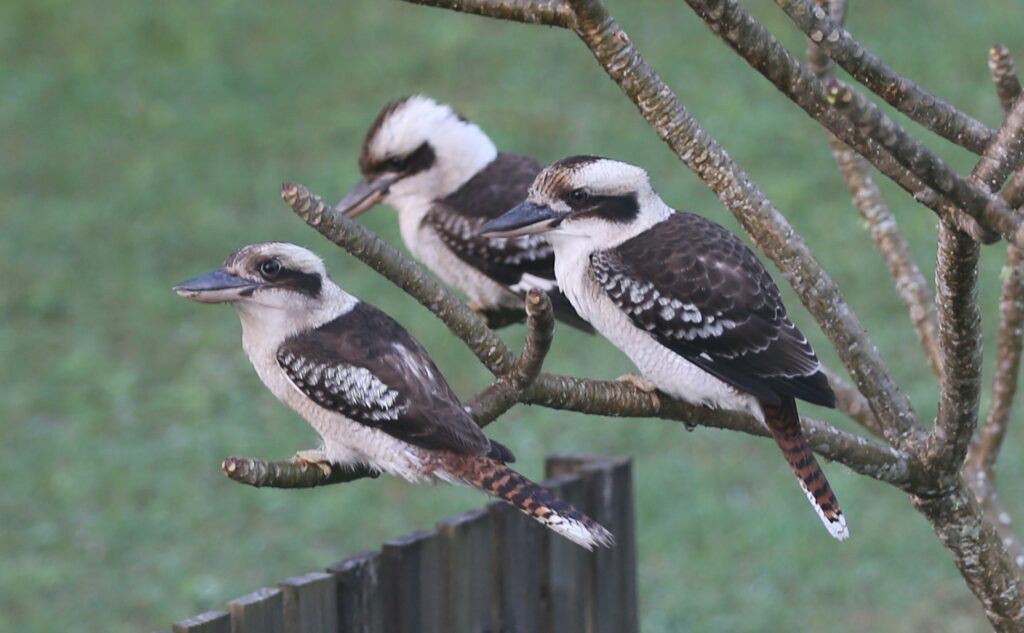
A Kookaburra tattoo may represent the enduring belief that good news is always on the horizon.
Conclusion
From Hollywood sound effects to suburban Australian backyards to famous nursery rhymes, the Kookaburra and its iconic laugh has made its way into the hearts of people all around the world. Whether you are a long-time Kookaburra-lover or a brand new initiate into the Kookaburra fan club, I hope that this article has given you one or two new things to enjoy and to cherish about this unique and expressive bird!
